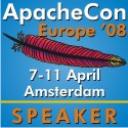Registration is now open for ApacheCon US 2008. There will be an Early Bird discount, so register early and Save! The schedule is up and I’m very happy to see the return of the schedule grid that shows the entire conference on one page. J. Aaron has done a great job on the site.
I will be presenting one session at the conference: Hardening Enterprise Apache Installations Against Attacks will discuss security issues with the Apache Web Server and how the developer team reacts to issues as they are found. We’ll also talk about protecting applications that are served by the Apache server and may be the target of attacks that do not subvert the web server itself, but the code behind it.
The first time I did this talk, at AacheCon EU 2008, I ran out of time. There’s so much to talk about! The feedback forms submitted by the attendees did, however, identify some spots I can tighten up, so I’m looking forward to present a new, updated version of the talk this fall.
Hope to see you, first week of November, in New Orleans!



 For programmers,
For programmers,